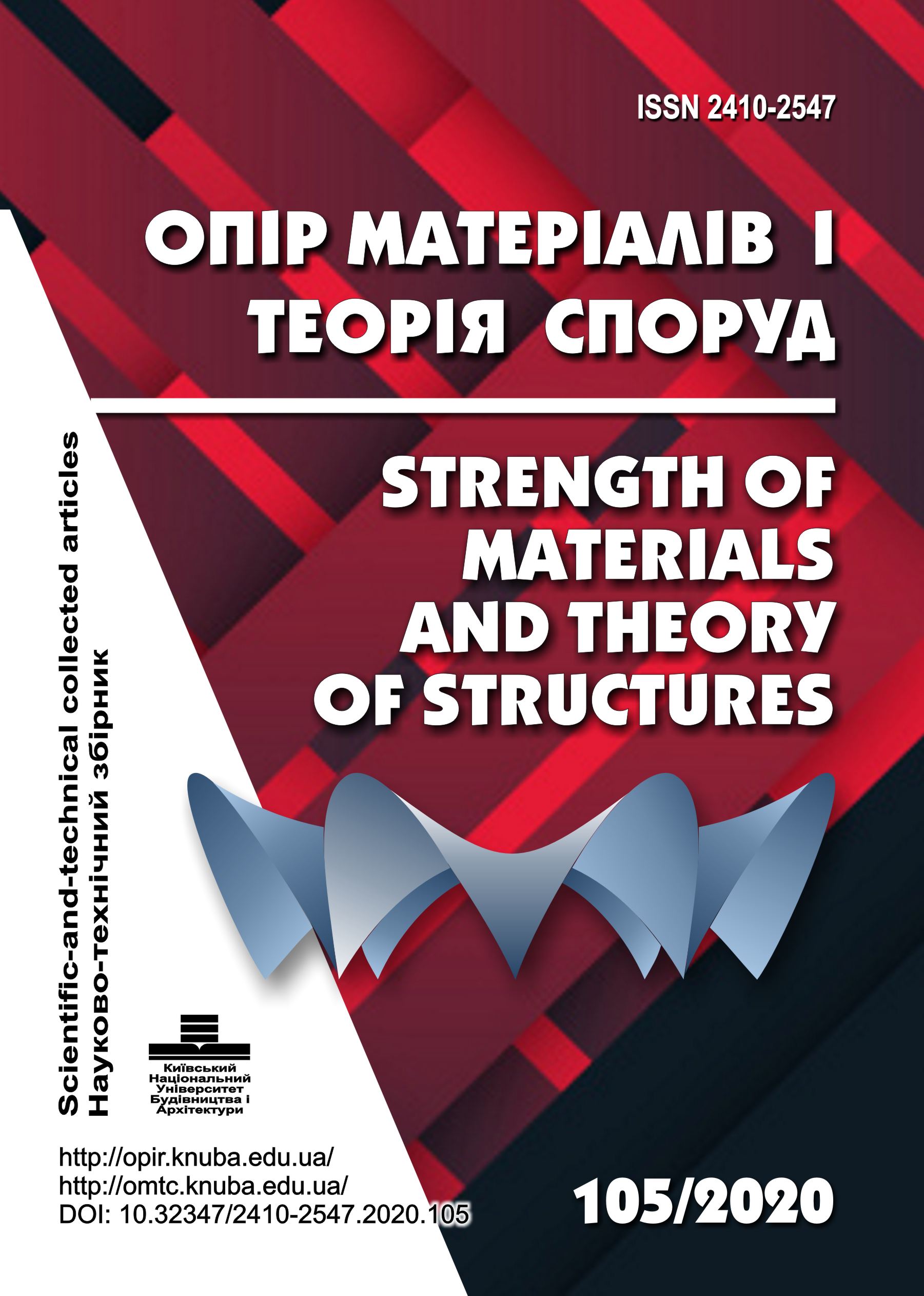Semi-analytical method of finished elements in elastic and elastic-plastic position for curviline prismatic objects
DOI:
https://doi.org/10.32347/2410-2547.2020.105.24-32Keywords:
finite element method, semi-analytical finite element method, block iteration method, linear and nonlinear equations, elastic and elastic-plastic deformation, Michlin polynomials, curvilinear prismatic bodiesAbstract
In [4, 5, 6] the algorithm of the method of block iterations of solving linear and nonlinear equations by the semivanalytic finite element method for curvilinear inhomogeneous prismatic bodies is realized. This paper presents the results of the effectiveness of the semi-analytical finite element method for the consideration of curvilinear prismatic objects in elastic and elastic-plastic formulation.
The choice of the optimal in terms of machine time and speed of convergence of the iterative process algorithm for solving systems of linear and nonlinear equations by the semivanalytic finite element method [1, 2, 3] is an important factor influencing the efficiency of the method as a whole. Numerous studies have shown that using the block iteration method to solve systems of equations of the semivanalytic finite element method for prismatic bodies with variable parameters has a number of important advantages over solving systems of the traditional variant of the finite element method.
The organization of the computational process and its software implementation takes into account the basic requirements for software for calculating strength on modern software packages. The modular structure of the developed system of programs provides its non-closedness concerning new classes of tasks.
The use of the block iteration method to solve systems of nonlinear equations of SAFEM is approximately an order of magnitude superior to the traditional finite element method.
References
Bazhenov V.A. Neliniine deformuvannia ta stiikist pruzhnykh obolonok neodnoridnoi struktury (Nonlinear deformation and stability of elastic shells of inhomogeneous structure) / V.A. Bazhenov, O.P. Kryvenko, M.O. Solovei – K. : ZAT «Vipol», 2010. – 315 p.
Bazhenov V.A. Chyselne modeliuvannia protsesiv neliniinoho deformuvannia til z urakhuvanniam velykykh plastychnykh deformatsii (Numerical modeling of nonlinear deformation processes of bodies taking into account large plastic deformations) / V.A. Bazhenov, Yu.V. Maksymiuk, I.I. Solodei, R.L. Stryhun – Kyiv: “Karavela”, 2019. – 223 p.
Bazhenov V. A. Napivanalitychnyi metod skinchennykh elementiv v zadachakh ruinuvannia prostorovykh til : Monohrafiia (Semi-analytical method of finite elements in problems of destruction of spatial bodies: Monograph) / V. A. Bazhenov, O. I. Huliar, S. O. Pyskunov, O. S. Sakharov – K. : KNUBA, 2005. – 298 p.
Huliar O.I. Universalnyi pryzmatychnyi skinchenyi element zahalnoho typu dlia fizychno i heometrychno neliniinykh zadach deformuvannia pryzmatychnykh til (Universal prismatic finite element of general type for physically and geometrically nonlinear problems of deformation of prismatic bodies) / O.I. Huliar, Yu.V. Maksymiuk, A.A. Kozak, O.V. Maksymiuk // Budivelni konstruktsii teoriia i praktyka – 2020. – Issue 6. – P. 72–84.
Maksymiuk Yu.V. Alhorytm rozviazannia systemy liniinykh ta neliniinykh rivnian napivanalitychnym metodom skinchenykh elementiv dlia kryvoliniinykh neodnoridnykh pryzmatychnykh til (Algorithm for solving a system of linear and nonlinear equations by the semivanalytic finite element method for curvilinear inhomogeneous prismatic bodies) / Yu.V. Maksymiuk, M.V. Honcharenko, I.Iu. Martyniuk, O.V. Maksymiuk // Budivelni konstruktsii teoriia i praktyka – 2020. – Issue 7. – P. 101–108.
Maksimyuk Yu.V. Basic relations for physically and geometrically nonlinear problems of deformation of prismatic bodies (Основні співвідношення для фізично і геометрично нелінійних задач деформування призматичних тіл) / Yu.V. Maksimyuk, S.O. Pyskunov, A.A. Shkril, O.V. Maksimyuk // Opir materialiv i teoriia sporud. – 2020. – Issue 104. – P. 255–264.
Downloads
Published
Issue
Section
License
Copyright (c) 2020 Viktor Bazhenov, Oleksii Shkril’, Yurii Maksymiuk, Ivan Martyniuk, Oleksandr Maksymiuk

This work is licensed under a Creative Commons Attribution 4.0 International License.
Authors retain copyright and grant the journal right of first publication with the work simultaneously licensed under a Creative Commons Attribution License that allows others to share the work with an acknowledgement of the work's authorship and initial publication in this journal.

